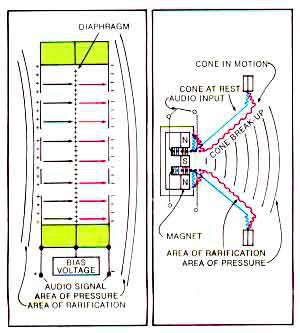KOSS One Brochure

The Impossible Dream
KOSS Model One Electrostatic Speakers
The Superiority of Electrostatic Speakers
The critical factors in determining the excellence of a speaker in achieving high accuracy musical reproduction fall into three vital areas of speaker performance. These are: transient response, non-linear distortion and flat spectrum common-path propagation. As you will see, electrostatic speakers are based on mechanical and electrical design concepts that provide superior performance in these critical areas.
A Comparison of electrostatic and dynamic modes of operation.
Electrostatic elements consist of three active parts: two acoustically open and electrically conductive parallel plates spaced apart and a thin conductive plastic membrane or diaphram stretched between these plates. When assembled the electrostatic element resembles a sandwich, with the plates on the outside amd the thin diaphram stretched tight in the middle.
The diaphram carries a high voltage, low current DC charge while the plates carry the audio signal. The charge on the diaphram establishes a reference bias potential that interacts with the audio signal on the plates causing the diaphram to move back and forth in syncronization with the audio signal. The electric field which acts to make the diaphram move exerts its actuating force uniformly over the entire area of the diaphram simultaneously. Thus, the entire diaphram moves with highly accurate phase and amplitude linearity throughout the entire range of motion and at all frequencies present in the audio signal.
In contrast, dynamic transducers consist essentially of a frame housing a magnet and a voice coil attached to the apex of a cone. The driving force is applied only to the voice coil. Since the coil is attached only to the apex of the cone, the cone must be extremely stiff in order for all parts of the cone to move as a single unit. However, because of the many natural resonances of the cone structure, a cone tends to move in a complex number of natural resonances at the same time that it is moving at the frequencies of the audio signal. The result is called ”cone breakup” or distortion. This breakup increases as the driving force increases, muddying and smearing the sharp attacks and decays of musical transients.
Comparing the moving mass of electrostatic and dynamic units.

Another factor that contributes greatly to the superiority of electrostatic transducers in the area of transient response and low distortion is the extremely low mass of the vibrating membrane. For instance, the moving diaphram in the KOSS Model One's electrostatic elements weighs no more than a layer of air 1/4 inch thick and of the same size as the element. This massless diaphram is, therefore, to stop and start in precise syncronization with the audio signal, with no lag or hangover. This ability to exactly track the audio signal results in an incredibly precise transient response.
On the other hand, the moving mass of dynamic transducers is normally hundreds of times that of a comparable electrostatic transducer. This additional mass makes it impossible for such devices to track the sharp attacks and decays of the audio signal as precisely as the electrostatic diaphram.
Constant-charge, linear excitation field
KOSS has designed electrostatic transducers with extremely low even and odd order harmonic distortion products. This performance is achieved by using a push-pull, constant-charge design concept.
Push-pull operation involves the simultaneous repulsion of the diaphram by one plate and the attraction of the diaphram by the other plate. This ”push-pull” action results in virtual cancellation of even order harmonic distortion. Unfortunately, the remaining odd order harmonic products are considerable more objectionable than their even order counterparts.
Electrostatic devices that are only push-pull operation suffer high levels of odd order harmonic distortion. This is true because the current flow on the diphram as it moves towards one of the plates. This increasing current flow causes a corresponding increase in the forces pulling the diaphram toward the plate.
This changing electric attraction causes a changing diaphram velocity, thereby producing non-linear motion and odd order harmonic distortion.
The development of the constant-charge principle makes possible the elimination of odd order harmonic distortion products in push-pull electrostatic designs. By inserting a very high resistance in series with the DC polarizing voltage to the diaphram, the
